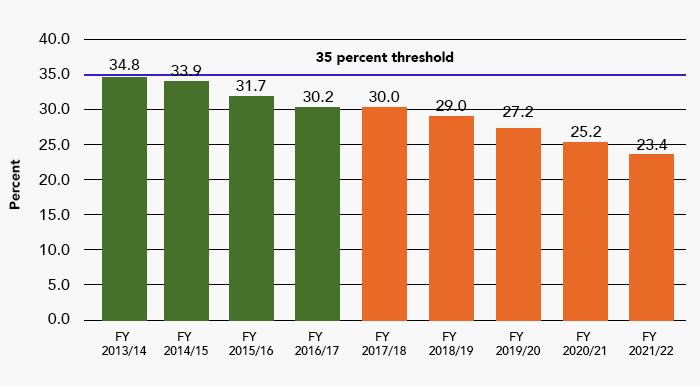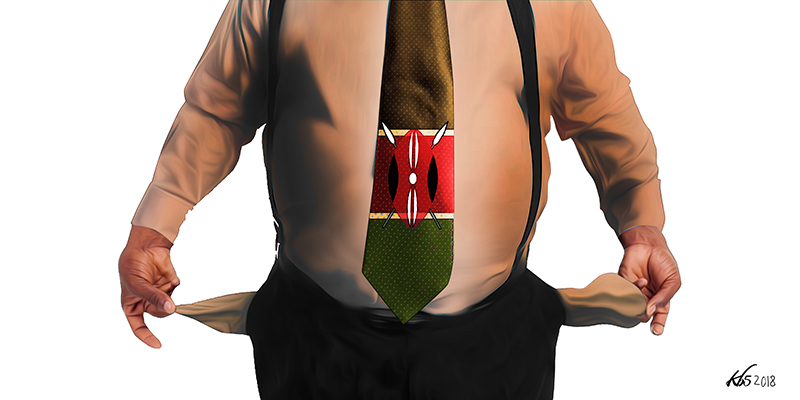Three weeks ago, Finance Cabinet Secretary Henry Rotich caused a stir when he reportedly declared the government broke. Rotich made the pronouncement in Parliament, when he gave notice that he would be presenting an austerity supplementary budget to plug a Ksh. 84 billion hole in the government’s finances. A day later, he retracted— with good reason. When Simeon Nyachae did so 20 years ago, he was promptly demoted to the Ministry of Industry. He declined the job and left government.
The pronouncement came hot on the heels of Mr. Rotich’s gallant return from the City of London waving a fistful of dollars, two billion of them, which he proclaimed a ringing endorsement of Jubilee’s economic stewardship, an emphatic vote of confidence in our economy by the global financial markets.
Three weeks ago, Finance Cabinet Secretary Henry Rotich caused a stir when he reportedly declared the government broke. Rotich made the pronouncement in Parliament, when he gave notice that he would be presenting an austerity supplementary budget to plug a Ksh. 84 billion hole in the government’s finances. A day later, he retracted— with good reason. When Simeon Nyachae did so 20 years ago, he was promptly demoted to the Ministry of Industry. He declined the job and left government.
Two questions arise. First, if you’ve just raised 10 percent of your budget in one fell swoop, you ought to be flush with cash. Second, economic growth as brisk as projected should swell the public coffers. And growth prospects ought to be strong. We know the Jubilee government has borrowed upwards of two trillion shillings in its first term, doubling our public debt in the process. This is a huge amount of money— about three times the GDP of Rwanda. The economic benefits of the SGR and the other infrastructure projects that this money has financed should be kicking in now. Jubilee’s economic math does not add up. Where has the money gone?
Let us start with where it has not gone.
It is not the wage bill. As this column has demonstrated on several occasions, all the wage bill hysteria is fake news. The wage bill has only increased 23 percent, well below the rate of revenue growth. In effect, wage outlays share of revenue has been falling. It is difficult to understand why government lies about the wage bill. It is even more difficult to understand how it expects to get away with it when its own reports tell the complete opposite such as demonstrated by the chart below, which appears in this year’s Budget Policy Statement.

It is not devolution either. Contrary to popular opinion, the establishment of counties did not entail expansion of government, or any new outlays. In fact, the number of elected representatives was reduced from more than 3,000 councillors to 1,450 county assembly members (MCAs). The money going to counties followed the functions. It should have been offset by reductions in national government budget on the same. In effect, devolution should be budget neutral.
The actual budget for (electricity) transmission and distribution is Ksh. 277 billion… Between half and two-thirds of the Ksh. 277 billion budget has been eaten.
In their first year of existence, the county governments’ revenue share came to Ksh. 193 billion but the deficit increased by only Ksh.66 billion. In the subsequent four years, county transfers have increased by 12 percent per year on average, while national government expenditure excluding county transfers has increased 16 percent per year, in other words, national government is gobbling money faster than the counties.
The wage bill and devolution are scapegoats.
In its four full financial years the Jubilee administration has posted capital budget to the tune of Ksh. 2.5 trillion. This is almost double the cumulative transfers to the counties over the same period (Ksh.1.3 trillion). Counties are mandated to invest a minimum of 30 percent on development but few manage to do so consistently. Cumulatively, capital spending in the counties is in the order of Ksh. 300 billion. Excluding the railway, the Jubilee administration has invested on average Ksh. 45 billion per county, while the county governments’ have spent an average of Ksh.6 billion. This means that on the ground, we should be seeing seven times as many, or bigger, national government development projects as county government ones. Where are they?
Between roads and power is a combined Ksh. 760 billion shillings which is still only a third of the Ksh. 2.1 trillion we need to account for. Where is the rest of it?
Roads are the obvious place to start. The Jubilee administration promised the mother of all road building programs. In 2013, they took over 1788 km of road under construction (new and major rehabilitations) from the grand coalition government, with a contract value of Ksh. 143 billion. By the end of 2016, the most recent published data available shows they had increased this tally to 1931 km with contract sum of Ksh. 221 billion. The data shows that 932 km of these roads worth Ksh. 95.8 billion were inherited, meaning that Jubilee had commissioned 1000 km of new roads for Ksh.126 billion. This is not earth shattering. In fact, of these only 315 km are new roads, the rest being rehabilitation and upgrading of existing roads.
But construction costs have gone up 44 percent, from Ksh. 80 million to Ksh. 115 million per kilometre. In 2014, crude oil prices plummeted from US$ 110 per barrel to an average of US$50 for the rest of the period. The cost of bitumen mirrors crude oil prices, and road construction also consumes copious amounts of diesel. Road construction costs ought to have fallen by at least 25 percent, which translates to Ksh. 55 million a kilometre. We are being fleeced at least Ksh. 55 million a kilometre of road build by Jubilee than we were being fleeced before.
The other big ticket infrastructure item is electricity, and one of the administration’s flagship ventures. Budget data shows a cumulative outlay of Ksh. 360 billion over the four years. These figures are questionable.
The electricity transmission operator Ketraco reports that it has completed 1800 km of transmission lines since it was set up in 2007. It has another 2400 km under construction. The construction cost of transmission lines are not published, but we can work around this. One of these lines, the Loiyangalani-Suswa transmission line has been in the news a lot for all the wrong reasons. The line is for evacuating power from the Turkana Wind Power project (which is actually in Marsabit county). The power project was completed in 2017, but the government failed to complete the transmission line in time meaning that we have to pay the investor over a billion shillings a month for power we are not consuming. This is part of the reason why electricity costs have spiked, but I digress.
I recently estimated the Uhuruto kleptocracy’s plunder at Ksh. 350 billion (US$3.5 billion) which ranked it fifth in the world kleptocracy league table, right behind Mobutu and Abacha in joint third (US$5 billion), Ferdinard Marcos in second (US$10 billion) all trailing Suharto at US$35 billion). It is beginning to look like a gross understatement.
The cost of the 428 km 400Kv transmission line is quoted as Euro 142 million (Ksh. 17.8 billion), which works out to Ksh 42 million a kilometre. The actual budget for transmission and distribution is Ksh. 277 billion. At Ksh 42 million a kilometre, this budget outlay is the equivalent of 6,600 kilometres of 400Kv transmission lines, 60 percent more than all the transmission lines built and under construction over the past decade. And most of the lines are not 400Kv lines. They are 220Kv and 132Kv, which cost considerably less. The reasonable cost of the 2800 kilometres of transmission lines under construction would be in the order of Ksh.100 billion. Between half and two-thirds of the Ksh. 277 billion budget has been eaten.
Policy and planning, and public financial management, whose only infrastructure is IFMIS, do not immediately strike one as capital-intensive undertakings. Investment in policy and planning has absorbed Ksh. 140 billion, an average of Ksh. 35 billion a year. Investment in public financial management has absorbed Ksh. 137 billion. Two functions that require no brick and mortar have consumed Ksh. 277 billion. SGR from Mombasa all the way to Konza? Computers and sex toys? There is something rotten in the state of Denmark.
The budget figures for roads are equally questionable. While, as we have already established, the actual road output is in the order of 1,800 kilometres costing Ksh. 220 billion, the budget documents reflect a capital outlay of Ksh. 400 billion. Last financial year alone, the budget was Ksh. 147 billion. At the Jubilee cost of Ksh.115 million per kilometre, this outlay works out to 3500 kilometres of road – 1,500 kilometres more than the projects underway at the end of 2006 as per latest published data. Could the Jubilee administration have commissioned 1500 kilometres of road in 2017? We are talking Mombasa-Nairobi three times, Lunga Lunga to Lokichoggio with 100 kilometres to spare. Admittedly, we did see Uhuru Kenyatta racing up and down the country commissioning things, but 1,500 kilometres is a stretch.
We are done with the big infrastructure things. Between roads and power is a combined Ksh. 760 billion shillings which is still only a third of the Ksh. 2.1 trillion we need to account for. Where is the rest of it?
Policy and planning, and public financial management, whose only infrastructure is IFMIS, do not immediately strike one as capital-intensive undertakings. Investment in policy and planning has absorbed Ksh140 billion, an average of Ksh. 35 billion a year. Investment in public financial management has absorbed 137 billion. Two functions that require no brick and mortar have consumed Ksh. 277 billion. SGR from Mombasa all the way to Konza? Computers and sex toys? There is something rotten in the state of Denmark.
As this column has demonstrated on several occasions, all the wage bill hysteria is fake news
Water and irrigation was funded to the tune of Ksh. 160 billion, but pray, why are we still ravaged by drought. Last year, we spent Ksh. 244 billion to import food, more than double the preceding five-year average of Ksh. 112 billion, and this year promises to be another bumper food import year. Thwake, the biggest dam ever comes with a price tag Ksh. 36 billion. It is not in these figures, but we’ve already been doing the equivalent of one every year. Youth and women have been empowered to the tune of Ksh. 60 billion. Youth and women enterprises should be thriving everywhere. And on and on it goes.
The puzzle of Jubilee’s economic math is no puzzle at all. Borrowed money has been plundered and squandered. It should not surprise. Kenya National Assurance, Kenya Meat Commission, KCB, National Bank, Kenya Airways, Uchumi, KCC, Mumias and countless others we have plundered state corporations, some several times over. It was only a matter of time before we plundered the Government itself.
I recently estimated the Uhuruto kleptocracy’s plunder at Ksh. 350 billion (US$3.5 billion) which ranked it fifth in the world kleptocracy league table, right behind Mobutu and Abacha in joint third (US$5 billion), Ferdinard Marcos in second (US$10 billion) all trailing Suharto at US$35 billion. It is beginning to look like a gross understatement.








